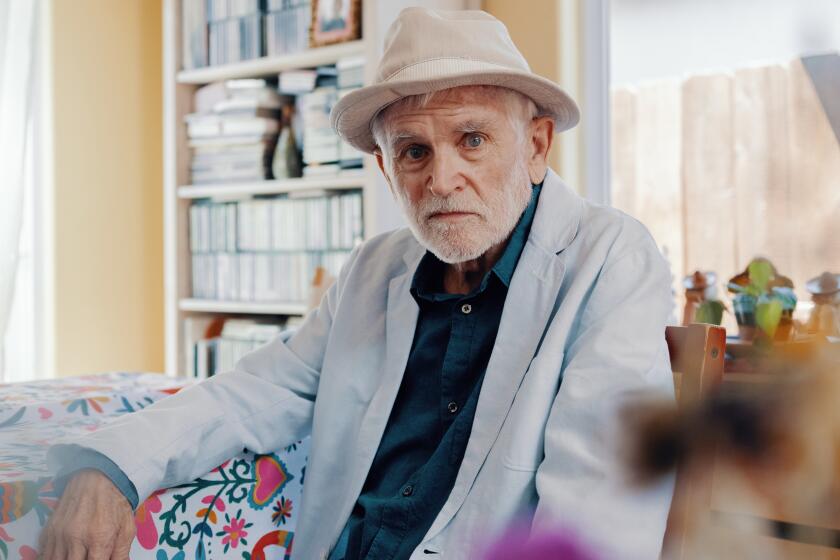Before and after Kerouac
- Share via
Joyce JOHNSON’S first memoir, “Minor Characters,” a chronicle of her romance with Jack Kerouac in the early 1950s, was a model of its kind, a beautifully balanced take on intimate emotions and their cultural context, a society in violent flux. Johnson escaped from genteel and restrictive parents, from an uptown middle-class Jewish upbringing, into the whatever-turns-you-on world of the Beat Generation and Greenwich Village, where she imbibed the liberating life of the Beats as if she were dying of thirst and it was water. She told this story freshly, with an artist’s control, using sight, sound and the other senses.
Johnson’s second, “Missing Men,” a memoir of her life with the Kerouac wedge removed, has a great deal of the immediacy of her earlier work. She animates long-dead family members as if they were characters in one of her novels: “I’m looking at a snapshot of [aunts] Anna and Leona on vacation in one of those resort camps where young white-collar workers began vacationing in the 1920s. On a rustic porch around twilight, the two unmarried sisters lean back in Adirondack chairs, bored and pensive in limp cotton dresses; a third woman broods in the shadows.... The three of them, all in their early twenties, seem unconsoled by each others’ company.” That’s almost all one needs to know about that time and those three sad people. Anna and Leona loom large in Johnson’s memory.
Their sister, Johnson’s mother, looms even larger. This was a woman with more agendas than true feelings. Johnson reports that her mother had been bent on finding a “gentleman” to marry, that is, “a Jewish fellow who didn’t seem Jewish.” Once married, she insisted on twin beds. Shortly after Joyce was born, her mother “couldn’t wait to measure [the baby’s] IQ.” But, Johnson writes, “no one had warned her about the essential thanklessness of motherhood.”
You get the idea. Joyce was raised in a cage, which, if not exactly gilded, was what we used to call “comfortable,” meaning enough to eat, plenty of attention and a roof that didn’t leak. But her mother was a demon: “[Her] exacting love depended on my bodily functions being as perfect as the rest of my behavior.” Given her real life, it comes as no surprise to learn that she “slipped into a secret life.” Thus, the ambiguous fate of many fiction writers. Maybe we should thank mean mothers for planting the seeds of creativity. Johnson calls Mom her “negative muse.”
Johnson -- then Joyce Glassman -- grows apace. She goes to Barnard College, where she has an affair with one of her teachers. She hooks up with Kerouac, even then celebrated as a founding member of the Beat Generation, but this part of her life is only alluded to here. After Kerouac and she split up, she dedicates herself to the life of a woman on the edge of poverty: Her assorted apartments feature collapsing ceilings and kitchens without sinks. She meets the love of her life, James Johnson, a hard-drinking painter, recently divorced. He converts to Judaism and they marry. Joyce Johnson, by now an editor in a New York publishing house, starts to write seriously. The marriage ends abruptly after little more than a year when he has a fatal accident on his Harley. Several years later, another painter, Peter Pinchbeck, enters her life. Johnson finds herself pregnant, at which point they marry in city hall. Her mother’s reaction: “ ‘Another Greenwich Village marriage!’ ” Baby Daniel complicates life; Johnson finds herself “running, running in circles -- from the baby to the subway ... to the job ... to the supermarket, to the apartment, which is never clean enough.... “ Pinchbeck, meanwhile, “admired the baby greatly -- from a distance.” By 1969, Johnson is aware that “[s]omething [is] clearly going wrong with our marriage.” They cohabit uneasily in a loft in pre-Soho Soho. Turns out that Pinchbeck, obsessed with making a name for himself as an artist, is a regular grouch. Johnson’s day job as an editor becomes more satisfying as she works on the books of rebels such as counterculture icon Abbie Hoffman and writer LeRoi Jones. Envious of her professional success, Peter acquires a girlfriend. They separate, reunite briefly, then split for good. “By 1980,” Johnson writes, “whole [art] movements I’d paid little attention to had come and gone.... “ The final 20 or so years are skimmed over in a few pages.
It may be that “Minor Characters” is too hard an act for this author to follow. The Kerouac book focused closely on a couple of years of a romance fraught with emotional complications and cultural explosion; this book slips from one time frame to another without the sturdy thread on which the beads of a story must be strung to hold the reader’s interest. The title, “Missing Men,” seems not so much a theme as an afterthought. Writing almost nothing about her work as an editor, Johnson allows none of her rebel authors to make even a cameo appearance -- a pity, because we would like to know what Hoffman and Jones were really like -- and she skips large slices of time altogether. Instead, she writes at length about Jim Johnson’s family members and other minor characters who aren’t all that interesting.
Still, Johnson is incapable of turning out a bad sentence. And her total recall for the details she does offer, gathered together, make a convincing and memorable portrait -- not only of an era but of the major character through it all: herself. *
More to Read
Sign up for our Book Club newsletter
Get the latest news, events and more from the Los Angeles Times Book Club, and help us get L.A. reading and talking.
You may occasionally receive promotional content from the Los Angeles Times.








